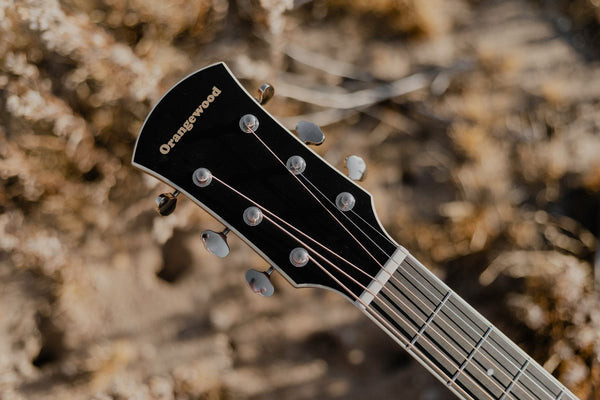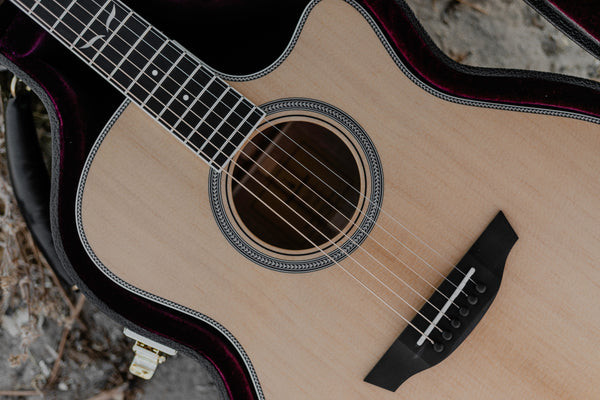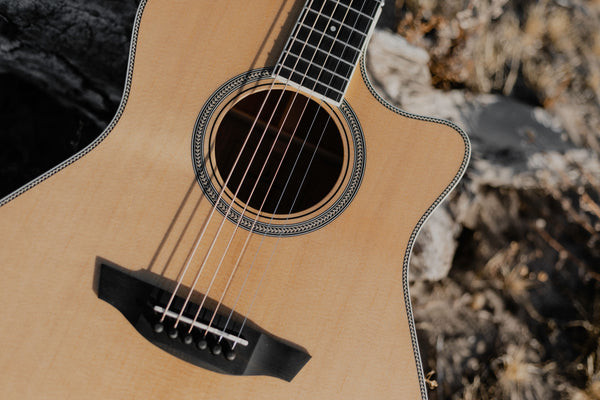Embarking on the journey of learning acoustic guitar is an exciting endeavor. As you begin to explore chords, strumming patterns, and melodies, one of the foundational steps is to familiarize yourself with the instrument itself. Understanding the different parts of your acoustic guitar is not just about knowing the names; it’s about speaking the language of guitarists, comprehending instructions, and ultimately, deepening your connection with your music.
Imagine trying to follow a guitar lesson when you’re unsure what the “headstock” or “bridge” refers to. Knowing the anatomy of your acoustic guitar eliminates this confusion, allowing you to learn more effectively and communicate clearly with instructors and fellow musicians. Let’s dive into a comprehensive guide that maps out all the essential parts of an acoustic guitar, making your learning process smoother and more enjoyable.
The Headstock: Command Center of Tuning
The headstock is situated at the very top of the guitar neck and serves as the anchor point for the tuning pegs. This critical part of the acoustic guitar endures considerable tension from the strings, so its strength is paramount for maintaining tuning stability. A robust headstock ensures that your guitar doesn’t constantly fall out of tune. You’ll notice headstocks can vary in shape and size, often depending on the guitar manufacturer’s design aesthetics.
Tuning Pegs: Fine-Tuning Your Sound
Housed within the headstock are the tuning pegs, also simply known as tuners or machine heads. These are the mechanisms you rotate to adjust the tension of each string, raising or lowering its pitch to achieve accurate tuning. When you replace your guitar strings, you’ll thread the new string through a hole in the tuning peg and wind it around the peg to bring the string up to pitch. Precise adjustments with the tuning pegs are essential for achieving the desired sound from your acoustic guitar.
 Close-up of a guitar headstock showcasing tuning pegs
Close-up of a guitar headstock showcasing tuning pegs
Neck and Fretboard: The Guitar’s Spine
Extending from the guitar’s body is the neck, a crucial component that incorporates several key parts: the fretboard, frets, headstock, and truss rod. The neck provides the structural foundation for playing and is designed for comfortable handling.
The Nut: String Spacing and Height
Positioned at the junction of the headstock and fretboard, the nut is a small, often overlooked but vital piece. It’s grooved to guide the strings from the headstock onto the fretboard, ensuring proper string spacing. More importantly, the nut dictates the string height above the fretboard at the headstock end. This height, known as the “action” at the nut, significantly impacts how easy or difficult it is to press down the strings in the lower positions of the neck. A well-cut nut is crucial for comfortable playability.
The Fretboard (Fingerboard): Your Musical Map
Laminated onto the neck is the fretboard, also called the fingerboard. This is the surface where your fingers interact directly with the strings to produce different notes and chords. By pressing strings down onto the fretboard, you shorten the vibrating length of the string, thus changing its pitch. Fretboards are typically crafted from different types of wood than the guitar’s neck, with popular choices including rosewood, ebony, and maple. The fretboard wood not only affects the guitar’s aesthetic but also contributes to its playing feel, style, and overall tone.
Frets: Dividing the Musical Landscape
Frets are the thin metal strips embedded across the fretboard, running perpendicular to the strings. These raised bars divide the fretboard into precise segments, each representing a semitone. When you press a string down just behind a fret, the fret acts as the termination point of the vibrating string length, producing a specific note. Standard acoustic guitars often come with around 20 frets, though some may have more or fewer depending on the design. Orangewood guitars typically feature 21 frets.
Fret Markers/Inlays: Navigational Aids
To assist players in navigating the fretboard, most guitars include fret markers or inlays. These are visual indicators embedded into the fretboard, often appearing as dots or more decorative shapes. They help you quickly identify positions on the fretboard, especially when playing chords or scales across different octaves. Common marker positions are at the 3rd, 5th, 7th, 9th, 12th, and 15th frets. Distinctive inlays, like Orangewood’s signature “leaf” inlay, can also serve as a brand identifier.
Truss Rod: Neck Adjuster for Optimal Play
Concealed within the neck is the truss rod, an adjustable metal rod. Its function is to counteract the immense tension exerted by the strings, which can cause the neck to bow over time. By adjusting the truss rod, you can control the curvature or “relief” of the neck. This adjustment is crucial for optimizing the guitar’s “action,” or the height of the strings above the fretboard. Proper truss rod adjustment can significantly improve playability and prevent issues like string buzzing or excessively high action. If you notice your guitar becoming difficult to play or experiencing tuning instability, adjusting the truss rod might be necessary.
The Body: Resonance and Tone
The body is the largest section of the acoustic guitar and plays a pivotal role in shaping the instrument’s sound. Acoustic guitar bodies come in various shapes and sizes, each influencing the guitar’s tonal characteristics and projection. Popular body shapes include dreadnought, grand concert, grand auditorium, parlor, and mini. The body is constructed from three main components: the soundboard (top), back, and sides.
Soundboard (Top): The Soul of the Sound
The soundboard, or top, is arguably the most crucial part of the acoustic guitar body in terms of sound production. It’s the large, resonant surface that vibrates when the strings are played, generating the majority of the guitar’s sound. The choice of “tonewood” for the soundboard is therefore paramount. Different woods possess unique resonant properties, resulting in distinct tonal qualities. Spruce, mahogany, and cedar are among the most common tonewoods used for soundboards, each offering a different sonic flavor. For instance, spruce is known for its bright and articulate tone, while mahogany provides warmth and richness.
Back and Sides: Shaping the Sound
While the soundboard is the primary sound generator, the back and sides of the guitar body also contribute significantly to the overall tone. They reflect and shape the sound waves resonating within the body, influencing the guitar’s volume, sustain, and tonal color. Like the soundboard, the woods used for the back and sides (often the same type of wood for both) impact the guitar’s sonic character.
Sound Hole: Projection Portal
Unique to acoustic instruments, the sound hole is the opening in the guitar’s body directly beneath the strings. It serves as the primary outlet for the sound generated within the guitar body. While sound radiates from the entire surface of the soundboard, the sound hole allows the internal resonance to project outwards freely, producing the characteristic acoustic guitar sound. The placement and size of the sound hole can also subtly affect the guitar’s tonal response.
Rosette: Decorative Ring
Encircling the sound hole is the rosette, an ornamental design inlaid into the soundboard. Beyond its aesthetic purpose, the rosette adds a touch of visual appeal to the guitar’s face. Guitar manufacturers often use different rosette patterns to distinguish their models or collections. For example, Orangewood guitars utilize various rosette designs across their Melrose and Highland collections, contributing to each series’ unique visual identity.
Pickguard: Protection Against Pick Scratches
Positioned adjacent to the sound hole is the pickguard, a protective piece typically made of plastic or similar material. Its primary function is to shield the delicate wood of the soundboard from scratches and wear caused by the guitar pick during strumming or picking. Pickguards come in a variety of shapes, sizes, and colors, allowing for some degree of customization in the guitar’s appearance. Many Orangewood guitars include an optional pickguard in the case, giving players the choice to install it for added protection.
 Acoustic guitar body featuring the soundhole, rosette, pickguard, and bridge
Acoustic guitar body featuring the soundhole, rosette, pickguard, and bridge
The Bridge: Anchoring the Strings to the Body
Located on the guitar’s body, below the sound hole, is the bridge. It serves as the anchor point for the strings at the body end, opposite the headstock. The bridge plays a crucial role in transferring the vibrations of the strings to the soundboard. Effective vibration transfer from the strings through the bridge to the soundboard is essential for maximizing the guitar’s volume and resonance.
Saddle: String Height and Vibration Transfer
Resting on top of the bridge is the saddle, a small strip of material, often made of bone, Tusq, or synthetic material. The saddle performs two key functions. First, it elevates the strings to the correct height above the fretboard at the body end, contributing to the overall string action. Second, and equally importantly, the saddle acts as the primary conduit for transferring string vibrations from the bridge directly into the soundboard. The material of the saddle can also subtly influence the guitar’s tone.
Bridge Pins: Securing the Strings
Bridge pins are small pegs that secure the strings into the bridge. Each string is inserted through a hole in the bridge, and a bridge pin is then inserted behind the ball end of the string to hold it firmly in place. Bridge pins are typically made from materials like plastic, wood, or bone, and while their primary function is utilitarian, some players believe that different bridge pin materials can subtly affect tone. When changing strings, you’ll remove and reinsert the bridge pins to release and secure the strings.
 Close-up of an acoustic guitar bridge showing saddle and bridge pins
Close-up of an acoustic guitar bridge showing saddle and bridge pins
By understanding these fundamental parts of your acoustic guitar, you’re now better equipped to learn, maintain, and truly appreciate your instrument. Each component plays a vital role in creating the rich and resonant sound of the acoustic guitar. As you continue your musical journey, this knowledge will not only enhance your understanding but also deepen your connection with the instrument you’ve chosen to explore. Happy playing!
